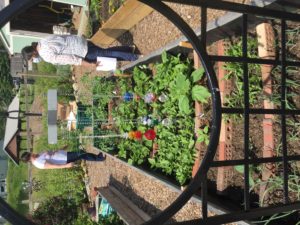Fall Gardening Pointers From the Bountiful Harvest Community Garden
go.ncsu.edu/readext?722013
en Español / em Português
El inglés es el idioma de control de esta página. En la medida en que haya algún conflicto entre la traducción al inglés y la traducción, el inglés prevalece.
Al hacer clic en el enlace de traducción se activa un servicio de traducción gratuito para convertir la página al español. Al igual que con cualquier traducción por Internet, la conversión no es sensible al contexto y puede que no traduzca el texto en su significado original. NC State Extension no garantiza la exactitud del texto traducido. Por favor, tenga en cuenta que algunas aplicaciones y/o servicios pueden no funcionar como se espera cuando se traducen.
Português
Inglês é o idioma de controle desta página. Na medida que haja algum conflito entre o texto original em Inglês e a tradução, o Inglês prevalece.
Ao clicar no link de tradução, um serviço gratuito de tradução será ativado para converter a página para o Português. Como em qualquer tradução pela internet, a conversão não é sensivel ao contexto e pode não ocorrer a tradução para o significado orginal. O serviço de Extensão da Carolina do Norte (NC State Extension) não garante a exatidão do texto traduzido. Por favor, observe que algumas funções ou serviços podem não funcionar como esperado após a tradução.
English
English is the controlling language of this page. To the extent there is any conflict between the English text and the translation, English controls.
Clicking on the translation link activates a free translation service to convert the page to Spanish. As with any Internet translation, the conversion is not context-sensitive and may not translate the text to its original meaning. NC State Extension does not guarantee the accuracy of the translated text. Please note that some applications and/or services may not function as expected when translated.
Collapse ▲Fall veggie gardening notes from Bountiful Harvest Community Garden manager and Master Gardener℠ Volunteer Jane Grossman:
“Now is the time to be planting a late summer crop for a fall harvest. Make sure to add some nutrients to the soil to give these new plants an extra boost such as blood meal or fish emulsion.
When to plant? Look at how many days it takes for the plant to reach its harvest date by seed or transplants. Count back from the average first frost date to see how much growing time there is.

Bountiful Harvest Community Garden manager Jane Grossman consults with a gardener on her vegetable plot.
When is the average first frost date? The range for Hendersonville is October 12-29 from multiple sources which is a wide swing. Somewhere in the middle, October 20 is a safe point to calculate from. From August 15, this Saturday, there will be 66 growing days for seeds/transplants to be harvested by October 20.
To ensure enough growing time for these later plantings, transplants are better than seeds with the exception of carrots which prefer growing from direct seeding.
With frost protection such as hoop tunnels, growing time can be extended beyond the October 20 first frost date estimate. Garlic overwinters and can be planted up until the end of October.
See the reference chart below with suggested plantings for late summer provided by NC State Extension for the WNC region. S indicates growing by seed and T indicates using transplants. It is always good to also go by the recommended days to harvest listed on seed packages and transplant labels.”
| Plant | Days to Harvest |
| Arugula | S=40–50 |
| Broccoli | T = 70–80 |
| Cabbage | T=63-75 |
| Cabbage, Chinese | T = 45–55 |
| S = 75–85 | |
| Carrots | S= 75-80 |
| Cauliflower | S=85-95 |
| T=55-65 | |
| Cilantro | S=50-55 |
| Collard Greens | T=32-72 |
| Dill | S=40-55 |
| Kale | T = 14–22 |
| S = 40–50 | |
| Kohlrabi | T = 22–32 |
| S = 50–60 | |
| Lettuce Head | T = 45–60 |
| S = 70–85 | |
| Lettuce Leaf | T = 15–25 |
| S = 40–50 | |
| Mustard | S=30–40 |
| Onion, green | T = 42–56 |
| S = 60–70 | |
| Pac choi/bok choi | T = 30–75 |
| Parsley | T = 33 |
| Radishes | S=20–25 |
| Rutabega | S=70–80 |
| Spinach | S=50–60 |
| Turnips | S=55–60 |
| GARLIC | B = 180-210 |




